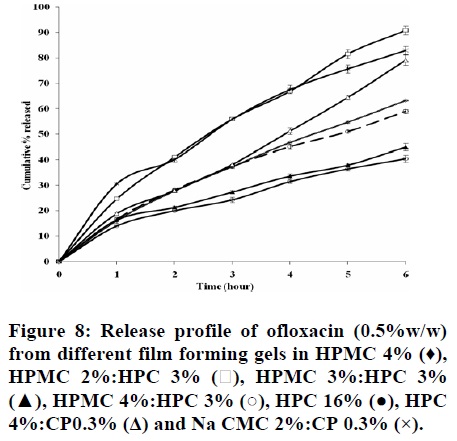Film forming gel for treatment of oral mucositis: In vitro studies
Keywords:
Mucositis, Film-forming gel, Rheology, In vitro studiesAbstract
Oral mucositis is one of the main complications of non-surgical cancer treatments. The present work focuses on the treatment or reduction of oral mucositis by using combined mechanism by formation of physical barrier by forming a film to cover the oral ulcer and use of therapeutic agents, such as diclofenac sodium and ofloxacin separately or in combination. The selected polymers for film forming gel formulations are Hydroxypropylcellulose (HPC), hydroxypropyl methylcellulose (HPMC), sodium carboxymethylcellulose (Na CMC) and carbopol 940 (CP). The residence time in simulated buccal saliva was between 5.5 to 6 hours for all formulations. The in-vitro release data of the investigated drugs from the prepared formulations followed zero-order and diffusion mechanism. The permeability studies data revealed that diclofenac sodium showed higher permeability from Na CMC/CP (2:0.3%) than from HPMC 4%, while in case of ofloxacin higher permeability was shown from Na CMC/CP (2:0.3%) than from HPMC/HPC (2:3%). The permeation parameters for diclofenac sodium and ofloxacin in their combination do not depend on either viscosity or pH, they depend on the type of polymers used.
References
Sonis S., Clark J. Prevention and management of
oral mucositis induced by antineoplastic
therapy. Oncology. 1991; 5: 11-18.
Rosenthal K. M. , Ganser C., A prophylaxis and
treatment of chemo-and radiotherapy- induced
oral mucositis-are there new strategies? Bone
Marrow Transplant. 1999; 24:1095-1108.
Bensadoun R.J. , Magne N. , Marcy P.Y. ,
Demard F. Chemotherapy and radiotherapy
induced mucositis in head and neck cancer
patients: new trends in pathophysiology,
prevention and treatment. Eur. Arch.
Otorhinolaryngol. 2001, 258: 481-487.
Scully C., Epstein J., Sonis S. Oral mucositis: a
challenging complication of radiotherapy,
chemotherapy, and radiochemo-therapy. Part 1:
pathogenesis and prophylaxis of mucositis. Head
Neck. 2003a; 25: 1057-1070.
Scully C., Epstein J., Sonis S. Oral mucositis: a
challenging complication of radiotherapy,
chemotherapy, and radiochemo-therapy. Part 2:
diagnosis and management of mucositis. Head
&Neck. 2003b;26: 77-84.
Kostler W.J., Heina M., Wenzel C., Zielinsiki
C.C. Oral mucositis complicating chemotherapy
and/or radiotherapy: options for prevention and
treatment CA. Cancer J. Clin. 2001; 51: 290- 315.
Toth B.B., Chambers M.S., Fleming T.J., Lemon
J.C., Martin J.W. Minimizing oral complications
of cancer treatment. Oncology. 1995; 9: 851-858.
Raber-Durlacher J.E. Current practices for
management of oral mucositis in cancer patients.
Support Care Cancer. 1999; 7: 71-74.
Shih A., Miaskowski C., Dodd M.J., Stotts N.A.,
Machphail L. A recent review of the current
treatments for radiation induced oral mucositis in
patients with head and neck cancer. Oncol. Nurs.
Forum. 2002; 29: 1063-1080.
Alterio D., Jereczek-Fossa B., Flore M., Piperno
G., Ansarin M., Orecchia R. Cancer treatment
induced oral mucositis. Anticancer Research.
; 27:1105-1126.
Ishida M., Rambu N., Nagai T. Mucosal dosage
form of lidocaine for toothache using
hydroxypropylcellulose and carbopol. Chem.
Pharm. Bull. 1982; 30: 4561-4564.
Ponchel G., Touchard F., Wouessidjewe D.,
Duchene D., Peppas N.A. Bioadhesive analysis of
controlled release systems: III. Bioadhesive and
release behavior of metronidazole-containing
polyacrylic acid-hydroxypropylmethylcellulose
systems. Int. J. Pharm. 1987; 38: 65-70.
Veillard M.M., Longer M.A., Mortens T.W.,
Robinson J.R. Preliminary studies of oral mucosal
delivery of peptide drugs. J. Control Rel. 1987; 6:
-131.
Devries M.E., Bodde H.E., Buscher H.J.,
Junginger H.E. Hydrogels for buccal drug
delivery: properties relevant for mucoadhesion. J.
Biomed. Mater. Res. 1988; 22: 1023-1032.
Senel S., Ikinci G., Kas S., Yousefi-Rad A.,
Sargon M.F. , Hincal A.A. Chitosan films and
hydrogels of chlorohexidine gluconate for oral
mucosal delivery. Int. J. Pharm. 2000; 193: 197-
Needleman I.G., Martin G.P., Smales F.C. An
investigation of bioadhesion for periodontal and
mucosal drug delivery. J. Clin. Peridontol. 1997;
: 394-400.
Nakamura F. In-vitro and in-vivo nasal
mucoadhesion of some water soluble polymers.
Int. J. Pharm. 1996; 134: 173-181.
Ahuja N. , Katare O.P. , Singh B. Studies on
dissolution enhancement and mathematical
modeling of drug release of a poorly watersoluble drug using water-soluble carriers. Eur. J.
Pharm. Biopharm. 2007; 65: 26–38.
Costa P., Lobo J.M.S. Modeling and comparison
of dissolution profiles. Eur. J.Pharm. Sci. 2001;
: 123–133.
Bottenberg P., Cleymaet R., Demuynck C.,
Remon J.P., Coomans D., Michotte Y. and Slop
D. In-vitro studies on buccoadhesive tablet
formulations of hydrocortisone hemisuccinate. J.
Pharm. Pharmacol. 1991; 43: 457.
Özgüney I.S., Karasulu H.Y., Kantarcı G., Sözer
S., Güneri T. , Gokhan E. Transdermal delivery of
diclofenac sodium through rat skin from various
formulations. AAPS Pharm. Sci. Tech. 2006; 7:
E1-E7.
Sznitowska M., Stokrocka M. Determination of
diclofenac released from suppositories using UV
spectrophotometery, spectra derivative
spectrophotometery and HPLC. Acta Poloniae
Pharmaceutica-Drug Research. 2007; 63:401-
Michailova V., Titeva St., Kotsilkova R.,
Krusteva R., Minkov E. Influence of aqueous
medium on the viscoelastic properties of
carboxymethyl cellulose, hydroxypropylcellulose,
and thermally pregelatinized starch gels. Colloids
and Surfaces A:physicochem. Eng. Aspects. 1988;
: 515-520.
Ferreira L.A., Seiller M., Grossiord J.L., Marty
J.P., Wepierre J. Vehicle influence on in vitro
release of glucose: w/o, w/o/w and o/w systems
compared J. Control Rel. 1995; 33: 349-356.
Panigrahi L., Pattnaik S., Ghosal S.K. The effect
of pH and organic ester penetration enhancers on
skin permeation kinetics of terbutaline sulfate
from pseudolatex-type transdermal delivery
system through mouse and human cadaver skins.
AAPS Pharm. Sci. Tech. 2005; 6: E167-E173.





